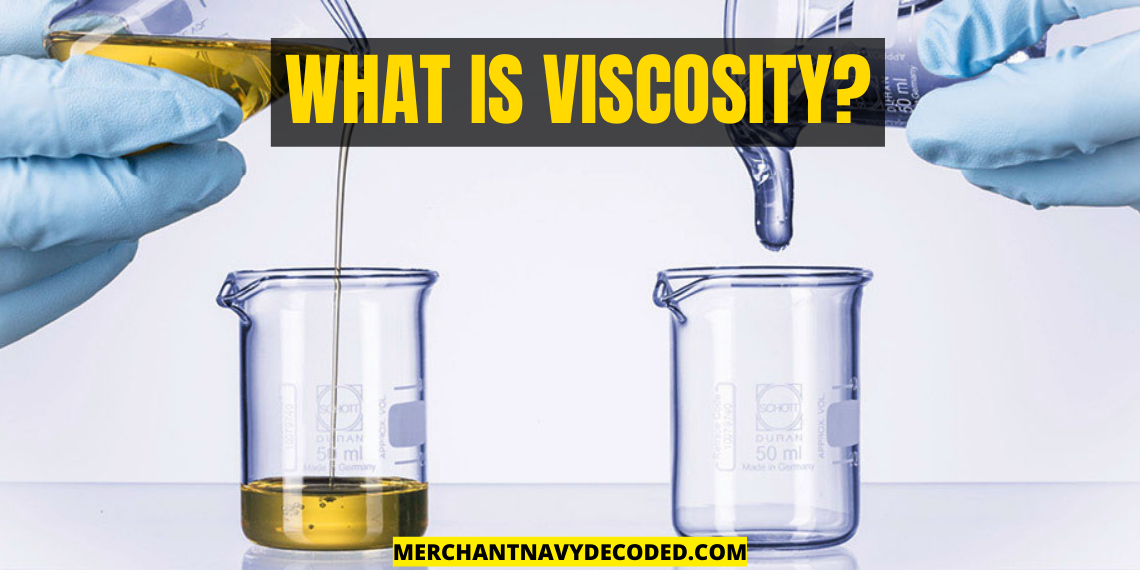What is Viscosity? Importance & its Relation to Temperature
Definition: It is the property of the fluid to oppose relative motion between its layers.
Example: Take a glass of water and pour it on the floor. It will spread all over the floor. On the other hand, take a glass of honey and pour it on the floor it will not flow easily due to its thickness. So the phenomenon that is opposing the flow of honey and easing the flow of water is occurring due to Viscosity.

Types of Viscosity:
- Absolute viscosity/ Dynamic viscosity
- Kinematic viscosity
Absolute viscosity: It is the fluid resistance to flow. Tangential force per unit area required to move one horizontal plane w.r.t another.

Kinematic viscosity:

All heavy oils and lube oils used on the ship are denoted by viscosity in cst at 50 °C
Viscosity and its relation with temperature:
Increasing the temperature of a substance decreases its viscosity which inturn increases the flow. Example: honey when in very cold temp like 15° C is very thick and will not flow easily, raise it to 45° C then the flow will increase and at 80° C it will flow like water.
Viscosity ∝ Temp. (for gases)
Viscosity ∝ 1/Temp (for liquid)
Why is viscosity important onboard a ship?
The quality of fuel on the ship is third-grade quality. It is very thick at 30° C so for burning it, we heat it to 130° C so that it can have a viscosity of 13 cst, the fuel we get on the ship has actual viscosity of 380 cst which is very thick at 50°C. So when fuel is heated, its viscosity reduces and proper injection takes place.
Importance of viscosity in lubrication:
Viscosity is important for lube oils. When we have two metals, one is stationary and the other is moving up and down, the clearance between both metals is very less. We need to lubricate it so that it does not create friction and get wear and tear. So viscosity is important in looking at how much is the clearance, if clearance is less, then we need less viscous lube oil otherwise it will not enter the between two surface clearances.
How is viscosity measured?
It can be measured by a device called a viscometer.
They are three types
- Capillary type
- Falling ball type
- Rotary type
Diagrams:



What is the Viscosity index?
It is the change in viscosity relative to temperature change. Lower viscosity index: more viscosity is affected with a change in temperature .Higher viscosity index: less viscosity is affected with a change in temperature. We want a higher viscosity index in lube oils because a good quality lube oil should not change its viscosity w.r.t change in temperature and a lower viscosity index in fuel oils because we want the viscosity to change w.r.t change with temperature.
Note:
If you want to learn more about this topic, we suggest checking out our Combo package with the given link https://merchantnavydecoded.com/courses/c/ . It’s a great way to dive deeper into the subject through video explanations. This package covers all the important details and presents them in an easy-to-understand format. Watching the videos will help you grasp the topic better and make learning more enjoyable. So, we highly recommend giving our Combo package a try to enhance your knowledge on the subject.
Disclaimer :- The opinions expressed in this article belong solely to the author and may not necessarily reflect those of Merchant Navy Decoded. We cannot guarantee the accuracy of the information provided and disclaim any responsibility for it. Data and visuals used are sourced from publicly available information and may not be authenticated by any regulatory body. Reviews and comments appearing on our blogs represent the opinions of individuals and do not necessarily reflect the views of Merchant Navy Decoded. We are not responsible for any loss or damage resulting from reliance on these reviews or comments.
Reproduction, copying, sharing, or use of the article or images in any form is strictly prohibited without prior permission from both the author and Merchant Navy Decoded.



Awesome article just revised all what I learned yesterday!!Thank You Parneet Sir you are gem hope this time I clear my GME and become a reputable Chief Engineer in coming years.😌
We love you sir.